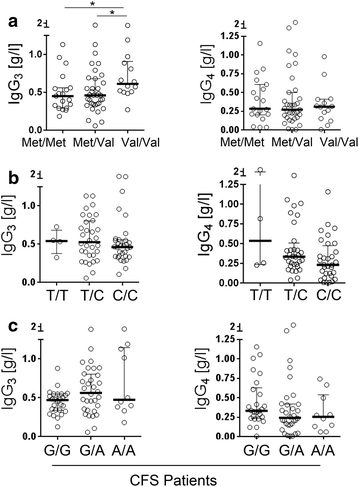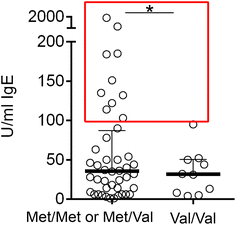Polymorphism in COMT is associated with IgG3 subclass level and susceptibility to infection in patients with chronic fatigue syndrome
- PMID: 26272340
- PMCID: PMC4536662
- DOI: 10.1186/s12967-015-0628-4
Polymorphism in COMT is associated with IgG3 subclass level and susceptibility to infection in patients with chronic fatigue syndrome
Abstract
Background: Chronic fatigue syndrome (CFS) is considered as a neuroimmunological disease but the etiology and pathophysiology is poorly understood. Patients suffer from sustained exhaustion, cognitive impairment and an increased sensitivity to pain and sensory stimuli. A subset of patients has frequent respiratory tract infections (RRTI). Dysregulation of the sympathetic nervous system and an association with genetic variations in the catechol-O-methyltransferase (COMT) and glucocorticoid receptor genes influencing sympathetic and glucocorticoid metabolism were reported in CFS. Here, we analyzed the prevalence of SNPs of COMT and glucocorticoid receptor-associated genes in CFS patients and correlated them to immunoglobulin levels and susceptibility to RRTI.
Methods: We analyzed blood cells of 74 CFS patients and 76 healthy controls for polymorphisms in COMT, FKBP5 and CRHR1 by allelic discrimination PCR. Serum immunoglobulins were determined by immunoturbidimetric technique, cortisol levels by ECLIA.
Results: Contrary to previous reports, we found no difference between CFS patients and healthy controls in the prevalence of SNPs for COMT, FKBP5 and CRHR1. In patients with the Met/Met variant of COMT rs4680 we observed enhanced cortisol levels providing evidence for its functional relevance. Both enhanced IgE and diminished IgG3 levels and an increased susceptibility to RRTI were observed in CFS patients with the Met/Met variant. Such an association was not observed in 68 non-CFS patients with RRTI.
Conclusion: Our results indicate a relationship of COMT polymorphism rs4680 with immune dysregulation in CFS providing a potential link for the association between stress and infection susceptibility in CFS.
Figures





References
MeSH terms
Substances
LinkOut - more resources
Full Text Sources
Other Literature Sources
Medical
Miscellaneous

